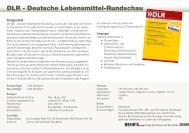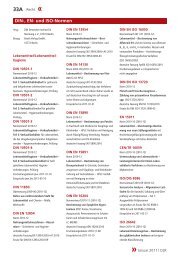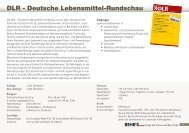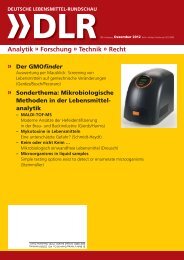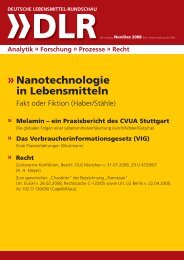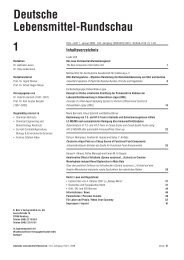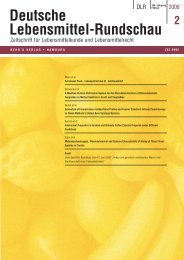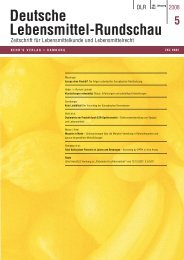Recht - DLR Online
Recht - DLR Online
Recht - DLR Online
Erfolgreiche ePaper selbst erstellen
Machen Sie aus Ihren PDF Publikationen ein blätterbares Flipbook mit unserer einzigartigen Google optimierten e-Paper Software.
adapted cells for dryness and elevated temperature for short<br />
time were used for the industrial production process. The<br />
purpose of this study was to optimise new cultivation strategy<br />
for the production of cells in high cell density culture.<br />
This step is considered as the first step for industrialization<br />
process for this type of biotherapeutic yeast.<br />
Materials and Methods<br />
Microorganism<br />
The yeast strain Saccharomyces boulardii ATCC-MYA-796<br />
obtained from (American Type Culture Collection, Manassas,<br />
VA, USA) was used in this study. This strain was<br />
adapted to dryness by successive adaptation method. Cells<br />
were grew on solid medium and allowed to dry on agar<br />
plate. After complete drying of culture, broth medium was<br />
added and the cells grew thereafter were isolated for further<br />
growth on solid medium. This process was repeated<br />
for more than 8 times.<br />
Media<br />
Growth medium<br />
For cell propagation on solid medium, yeast-peptone-dextrose<br />
(YPD) medium was used. This medium composed of<br />
(g l -1 ): glucose, 10; yeast extract, 3; peptone, 3 and agar, 20.<br />
The pH was adjusted to 4.5 before sterilization.<br />
Production medium<br />
Two types of broth media were used in this study. The first<br />
medium used in this study was complex (YMG) medium.<br />
This medium was composed of (g l -1 ): Malt extract, 10.0;<br />
yeast extract, 4.0; glucose, 4.0. The pH was adjusted to 5.5<br />
before sterilization. Unless otherwise mentioned, the yeast<br />
production medium applied was complete synthetic medium<br />
(CSM). This medium was composed of (g l -1 ): Glucose,<br />
15.0; (NH 4 ) 2 SO 4 , 5.0; KH 2 PO 4 , 3.0.; MgSO 4 x7H 2 O,<br />
1.0. The pH was adjusted to pH 5.5 before autoclaving.<br />
Glucose was sterilized separately by autoclaving at 110 ºC<br />
and added to the medium aseptically before inoculation.<br />
Cultivation conditions<br />
Shake flask cultivation and inoculum preparation<br />
In case of shake flask culture, the submerged cultivations<br />
were carried out in 250 ml Erlenmeyer flasks containing<br />
50 ml of growth medium. After inoculation, the flasks were<br />
incubated aerobically on a rotary shaker (Annova 4330,<br />
New Brunswick Scientific Co., NJ, USA) at 200 rpm and<br />
30 °C for 24 h. Cells were used thereafter to inoculate the<br />
bioreactor with inoculum concentration of 5 % (v v -1 )<br />
Bioreactor cultivation<br />
For bioreactor experiments, cultivations were carried out<br />
in 3.0 l stirred tank bioreactor, Bioflo III (New Brunswick<br />
Scientific Co., New Brunswick, NJ, USA), with a work-<br />
ing volume of 1.5 l. Agitation was performed using a three<br />
4-bladed Rushton turbine impellers (d i(impeller diameter) = 65 mm;<br />
d t(tank diameter) = 135 mm, d id t -1 = 0.48) at 300 rpm. Aeration<br />
was performed by filtered sterile air [1 v v -1 min -1 ]. Dissolved<br />
oxygen concentrations were analyzed by polarographic<br />
electrode (Ingold, Switzerland). Foam was suppressed,<br />
when necessary, by the addition of silicon antifoam reagent<br />
(Fluka, Switzerland). In controlled pH batch cultures and in<br />
fed-batch experiments, pH was controlled at 5.5 by addition<br />
of 2.5 Mol l -1 NH 4OH.<br />
Sample preparation and cell dry weight determination<br />
In case of bioreactor cultivations, aliquots (in form of<br />
20 ml) of the culture were taken from the bioreactor vessel<br />
through a sampling system. Cell concentration was determined<br />
immediately by spectrophotometer (Pharmacia Biotech,<br />
Cambridge, England). The optical density of the culture<br />
at 600 nm after diluting the samples into the optical density<br />
range was of 0–0.5. The samples were then filtered using preweighed<br />
filter paper and the filtered biomass was washed<br />
twice by distilled water and subsequently dried in an oven at<br />
110 °C for a constant weight. The relation between OD and<br />
cell dry weight was then determined using standard curve between<br />
the OD and cell dry weight. The filtrate was frozen at<br />
–20 °C and used for glucose determination.<br />
Analysis<br />
Cell mass determination<br />
Optical density of the cell cultures was determined by an<br />
absorbance measurement at 600 nm with a spectrophotometer.<br />
The OD of culture was converted to dry cell mass<br />
through a linear correlation established for the instrument.<br />
Biomass concentration is defined as dry cell mass per unit<br />
volume of culture (g l -1 ).<br />
Determination of glucose<br />
The glucose concentration in the cultivation medium was<br />
determined enzymatically using glucose determination kit<br />
(Biocon GmbH, Germany). The intensity of developed<br />
color was determined at 500 nm using spectrophotometer<br />
(Pharmacia Biotech, Cambridge, England).<br />
Results and Discussions<br />
The production of S. boulardii cell mass was studied in different<br />
cultivation media to improve the production process.<br />
Therefore, three different media namely: complex media,<br />
chemically defined media and semi-defined medium (defined<br />
medium supplemented by yeast extract) were used for<br />
yeast cultivations in batch mode in both shake flasks and<br />
bioreactor. The data of these experiments were used as platform<br />
to design fed-batch cultivation process with different<br />
feeding strategies to cultivate the cells in high cell density<br />
culture.<br />
424 ı Originalarbeiten Deutsche Lebensmittel-Rundschau ı 104. Jahrgang, Heft 9, 2008




